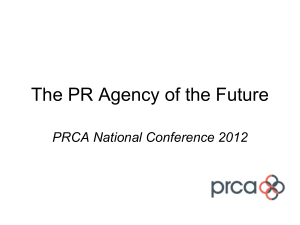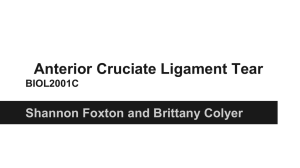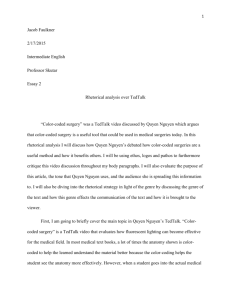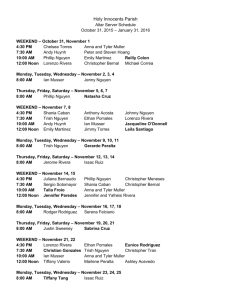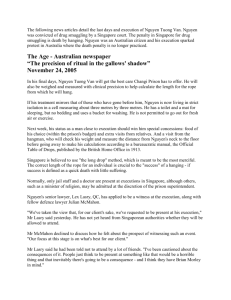DOWNLOAD and VIEW the full-length interview with Dr
advertisement
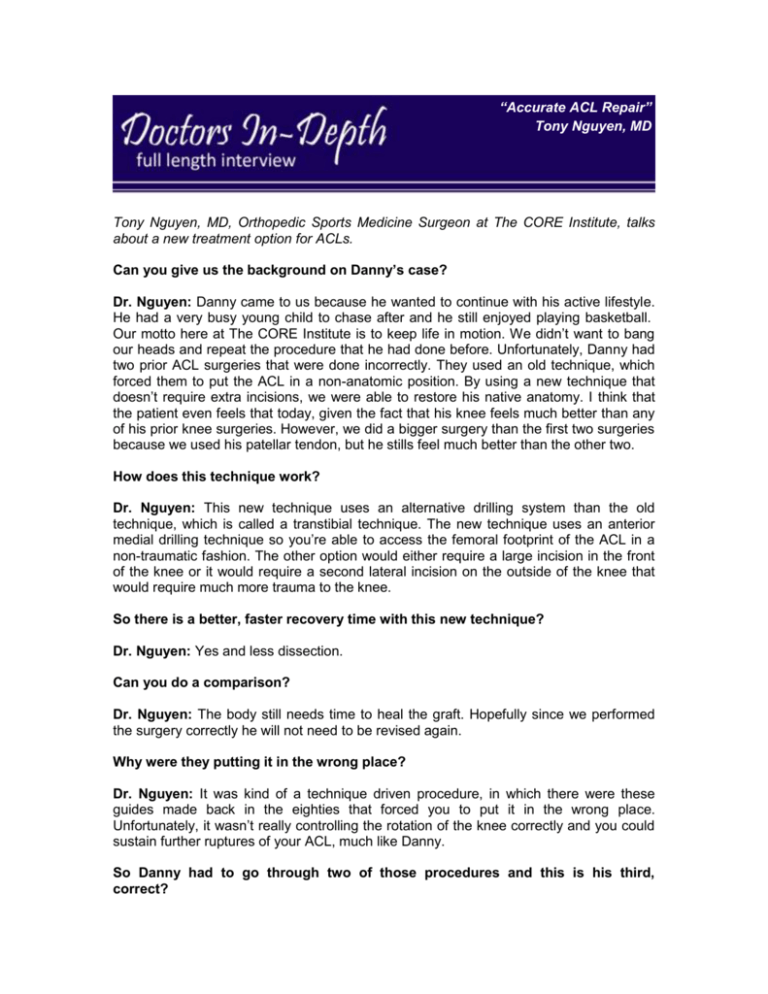
“Accurate ACL Repair” Tony Nguyen, MD Tony Nguyen, MD, Orthopedic Sports Medicine Surgeon at The CORE Institute, talks about a new treatment option for ACLs. Can you give us the background on Danny’s case? Dr. Nguyen: Danny came to us because he wanted to continue with his active lifestyle. He had a very busy young child to chase after and he still enjoyed playing basketball. Our motto here at The CORE Institute is to keep life in motion. We didn’t want to bang our heads and repeat the procedure that he had done before. Unfortunately, Danny had two prior ACL surgeries that were done incorrectly. They used an old technique, which forced them to put the ACL in a non-anatomic position. By using a new technique that doesn’t require extra incisions, we were able to restore his native anatomy. I think that the patient even feels that today, given the fact that his knee feels much better than any of his prior knee surgeries. However, we did a bigger surgery than the first two surgeries because we used his patellar tendon, but he stills feel much better than the other two. How does this technique work? Dr. Nguyen: This new technique uses an alternative drilling system than the old technique, which is called a transtibial technique. The new technique uses an anterior medial drilling technique so you’re able to access the femoral footprint of the ACL in a non-traumatic fashion. The other option would either require a large incision in the front of the knee or it would require a second lateral incision on the outside of the knee that would require much more trauma to the knee. So there is a better, faster recovery time with this new technique? Dr. Nguyen: Yes and less dissection. Can you do a comparison? Dr. Nguyen: The body still needs time to heal the graft. Hopefully since we performed the surgery correctly he will not need to be revised again. Why were they putting it in the wrong place? Dr. Nguyen: It was kind of a technique driven procedure, in which there were these guides made back in the eighties that forced you to put it in the wrong place. Unfortunately, it wasn’t really controlling the rotation of the knee correctly and you could sustain further ruptures of your ACL, much like Danny. So Danny had to go through two of those procedures and this is his third, correct? Dr. Nguyen: Yes, this actually is his third and we are hopeful, his last. What is the failure rate with those then? Dr. Nguyen: With those, it’s usually reported about four to five percent. What is the failure rate with the new technique? Dr. Nguyen: The new technique has only been around for a few years; however the failure rate is probably the same. There were two things that went wrong with Danny’s technique. First, he was very young and they used a donated cadaver, which increases the re-rupture rate by about 25 percent. Second, the ACL was placed in the wrong position. With this new technique and utilizing his own tendon, the reported rupture rate is about four or five percent. How big of a breakthrough would you say this is for ACL repair? Dr. Nguyen: For the sports medicine community, this technique a very big breakthrough. It allows us to restore the anatomy and restore the rotational control that the ACL allows for the knee. Do you think there will be an army of people who are re-rupturing this tendon that had the same procedure? Dr. Nguyen: Yes, in fact I’ve done an army already. Well, I’ve done a good amount, probably about twenty or thirty patients in the past two or three years that had the old technique with cadaver graft. Those two things together don’t really mix well and unfortunately we’ve had to do multiple revisions. Danny was lucky that we were able to do his surgery in one procedure and he is back to keeping life in motion. Would he have had this injury at all if he did not resume his active lifestyle? Dr. Nguyen: If Danny never played basketball again after having the first surgery performed, he probably would not have ruptured it again, but the fact that he went back to an active lifestyle after surgery is why he probably re-ruptured. If Danny limited the active lifestyle to avoid stress on the knee, he would have probably not re-ruptured his ACL. With this new technique, are people able to get back to an active lifestyle? Dr. Nguyen: Yes they are. With this procedure, I am hopeful Danny will be back to participating in activities he loves, like playing basketball. How nervous is Danny and what have you told him? Dr. Nguyen: I think Danny is less nervous these days because of the way his knee feels. It feels like a normal knee to him because the important thing is that we restored his anatomy. However, prior to his surgery I know that he and his wife were very anxious to having another knee surgery that may or may not have worked. He is five weeks into it now. How much longer before he has a full recovery? Dr. Nguyen: I would expect him to probably start jogging anywhere between four to six months. As far as returning to sports, depending on how his rehab goes, it could be anywhere from six to nine months. Is there any advice you can give to people who have had the old procedure? Dr. Nguyen: Pay attention to your knee. If its giving away on you or doesn’t feel normal. See an orthopedic surgeon. You know your body better than anyone else. Let’s say someone has had the old procedure and has not had it re-rupture, should they go for the revision or take their chances? Dr. Nguyen: I would probably take my chances. I wouldn’t voluntarily have a revision until it tore again or was having instability. How many sports surgeons are actually doing this type of procedure? Dr. Nguyen: Most people, who are graduated recently from fellowships or are concerned with anatomic restoration of the ACL, are performing it. Is this new technique more anatomically correct? Dr. Nguyen: Yes it is more anatomically correct. Why wasn’t that the original idea or why did it take so long? Dr. Nguyen: The technique originally went from being anatomic to a single incision or transtibial incision, because surgeons wanted to decrease the scarring and the amount of incisions created. Unfortunately, that forced us to put it in to a bad position. We are now figuring out how to put it in the right position with minimal scarring, minimal incisions. So it was with good intentions it just didn’t work out so well? Dr. Nguyen: Correct. What is scarring like now? Dr. Nguyen: Scarring has improved. There’s still some scarring, however physical therapy is a very helpful adjunct to this. This information is intended for additional research purposes only. It is not to be used as a prescription or advice from Ivanhoe Broadcast News, Inc. or any medical professional interviewed. Ivanhoe Broadcast News, Inc. assumes no responsibility for the depth or accuracy of physician statements. Procedures or medicines apply to different people and medical factors; always consult your physician on medical matters. If you would like more information, please contact: Tony Nguyen, MD Orthopedic Surgeon in Sports Medicine and Trauma The CORE Institute 1-866-974-2673 Sign up for a free weekly e-mail on Medical Breakthroughs called First to Know by clicking here.


